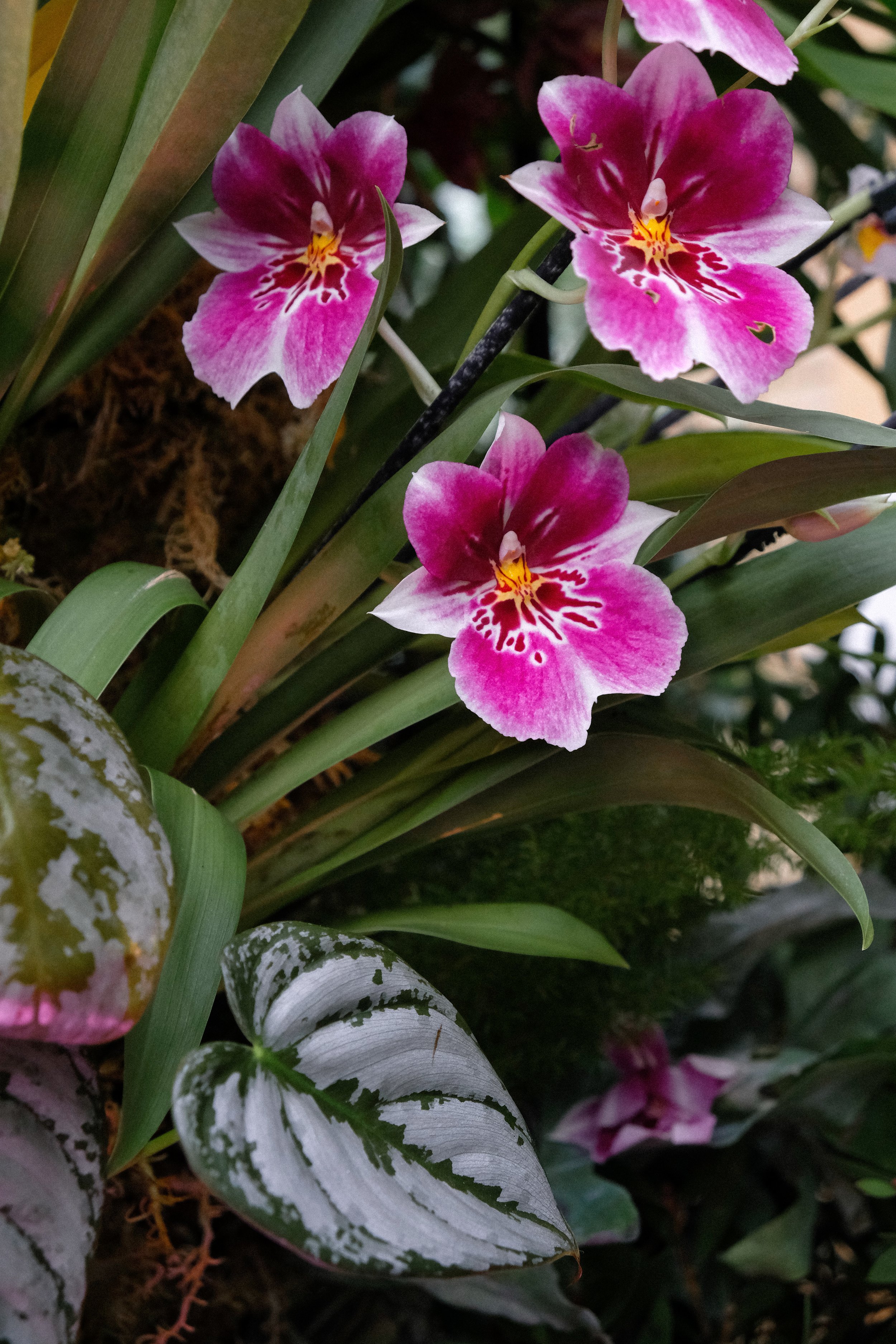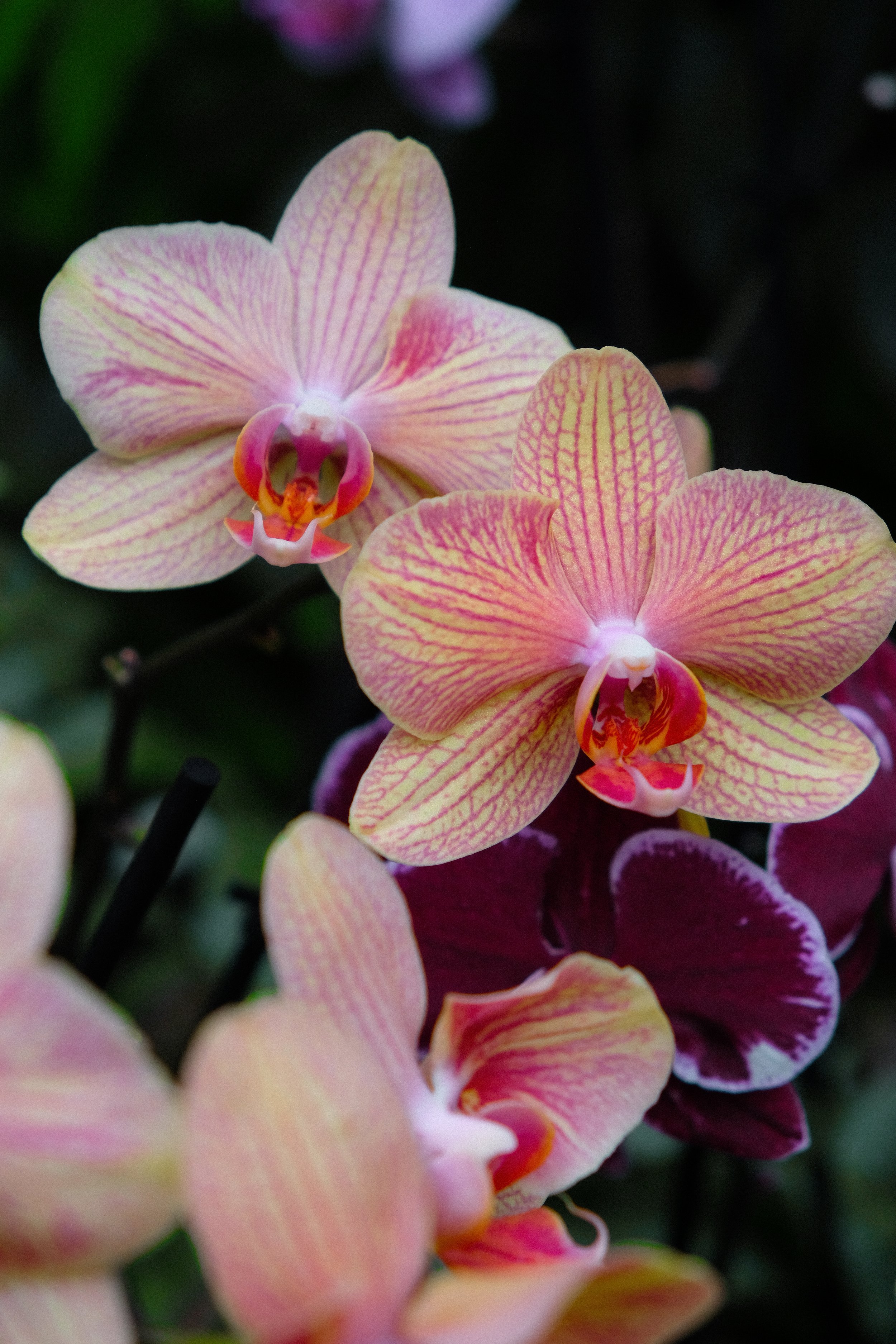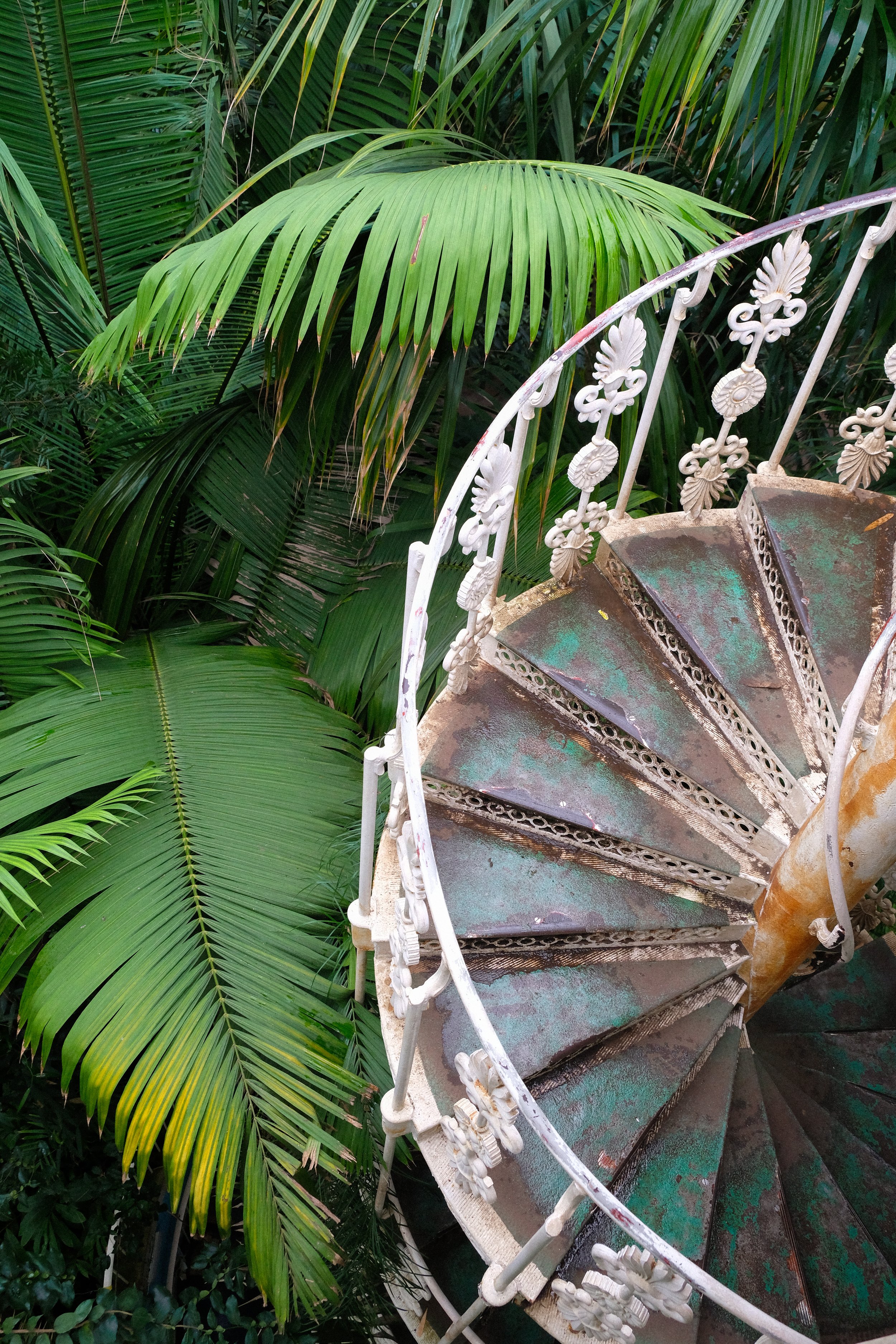Kew Gardens: Winter Edition
Kew Gardens – an oasis of nature in London – is one of our favourite places to visit. We usually visit in warmer months when flower beds are awash with colour but seeking a winter day out and having never visited during their annual winter orchid festival, we booked our tickets. The weather on the day was absolutely dreadful. However, torrential rain showers, dark clouds, and a wet weather chill did little to dampen the wonderful day we had. The orchid festival, with its unapologetic celebration of vibrant flora, could bring cheer to any grey day.
We knew the day was going to be great when, on arrival, we spotted a green woodpecker feeding on insects in the soggy grass. Its chartreuse plumage nearly blended in with the ground but there was no missing its scarlet head. We had time for morning coffee and pastries, which we enjoyed in the Orangery Café, watching the rain fall and the pairs of geese taking it in turns to forage for food.
The orchid festival took place in the Princess of Wales Conservatory, a setting which presents the chance to travel the world within a single glasshouse. With ten climate zones, this glassy labyrinth leads you through a series of fascinating ecosystems, including dry and arid landscapes good for cacti, wet zones where giant waterlilies float and humid regions where tropical flowers thrive.
This year’s festival was inspired by the landscape of Madagascar, a place of spectacular natural beauty and biodiversity. The orchids were absolutely mesmerising, exquisitely presented in a series of dazzling horticultural displays across the different areas of the glasshouse. Lovers Baobab, one of the most beautiful deciduous trees, and central to Madagascar’s ecosystem, was recreated in a breathtaking display on the waterlily pond. Colours that we did not know existed naturally in the wild were on full display, and a menagerie of friendly-looking animals had been charmingly sculpted out of natural materials, including ring-tailed lemurs, chameleons, fruit bats, radiated tortoises, and the enigmatic aye-aye, the world’s largest nocturnal primate. An uplifting and rhythmic soundscape to celebrate Malagasy music accompanied the visit.
Possibly the coolest plant of the day was the strongylodon macrobotrys, or as it’s more commonly known: the jade vine. This striking plant is a minty, turquoise colour, a colour we never realised was naturally occurring. Their jade-green flowers cascade beneath a canopy of pale green foliage. It originates from the rainforests of the Philippines and in the wild, the vine is pollinated by bats. The bats hang upside down to drink the nectar, and the plant gently brushes pollen onto the bat’s head while it drinks. The next plant the bat visits collects the pollen from the first before brushing its own pollen to be transported elsewhere. It is a great example of co-evolution in action. To recreate the plant’s native pollinating habits, horticulturalists at Kew, using their hands, mimic the effect of bats visiting the plant to drink nectar.
Everywhere you looked your eyes fixated on visual showstoppers of orchids in all sorts of shapes and sizes. There were some with apricot petals and indigo spots; others were shaped like stars with leopard-like patterns; some had spindly petals that looked like spider legs; others were gorgeous shades of cerise, chocolate, tangerine, lime, lilac, puce, and plum. The festival really was a sensory delight and a mood brightener as the rain continued to fall outside.
After a fantastic tour of the orchids, we headed to Kew’s most famous building, the Palm House. The rain was quite heavy at this point, so the warmth of the indoor rainforest was particularly welcome.
Built in the 1840s, the breathtaking Palm House is at the heart of Kew and here you can see the world’s oldest potted plant, the Eastern Cape giant cycad. This prickly plant has been growing since 1775. White, wrought-iron spiral staircases elevate you to the glasshouse’s heavens, and from this upper walkway you get right among the branches of the larger plants and get a wonderful view of the luscious vegetation below.
After the Palm House we headed to the Shirley Sherwood Gallery of Botanical Art, which was showing the work of contemporary artist Mat Collishaw. The exhibition, entitled Petrichor, showcased the variety of pioneering techniques used by Collishaw, including the use of video, photography and the power of illusion, to explore the relationship between art and nature. If you’ve read some of our previous blogposts, you’ll know how much we love the still life paintings of the Old Masters’ with their moody black backdrops and exquisitely detailed floral arrangements. Thus, Collishaw’s Alluvion (2023) series was particularly popular. Alluvion is a collection of oil paintings inspired by the work of seventeenth-century artists such as Frederik Ruysch and Abraham Mignon. He used an algorithm to combine the Old Masters’ works with insect body parts and from the resulting AI-generated images, he painted the series. As you move closer to the paintings you will see that the flowers are subtly insect-like. This concept has been inspired by something naturally occurring in the wild. Flowers, particularly orchids, have evolved to simulate female insects in order attract courting male insects to inadvertently pollinate their flower species, something known as Pouyannian mimicry. This form of natural mimicry evolves over generations. In this work, Collishaw’s contemporary comment is that there is a great similarity here to what is happening with artificial intelligence and digital media, technologies that are changing the landscape we live in. A floral sculpture series entitled The Venal Muse (2012) was displayed alongside Alluvion. These sculptures have fleshy, animalistic textures and shapes. Morbid fascination had us captivated by the rather gruesome petals, which also bore anthropomorphic scars and sores. The work is inspired by the decadence and lost innocence of Charles Baudelaire’s Les Fleurs du Mal. We also liked the piece entitled Albion (2017) which dominated the main gallery. A huge, spectral laser scan of the 800-year old major oak tree in Sherwood Forest fills the space. In the last gallery you experience the sensory overload that is The Centrifugal Soul (2016), a modern zoetrope in which strobe lights flicker as the central installation spins to animate bowerbirds and birds of paradise doing their mating dances against a backdrop of ornate flowers. It was a fascinating and thought-provoking exhibition, and one we thoroughly enjoyed.
Next door to the Shirley Sherwood Gallery is the Marianne North Gallery, a permanent collection that allows you to travel to every corner of the globe through an extraordinary collection of botanical, landscape, and still-life paintings by Victorian female biologist, Marianne North. More than 800 nineteenth-century paintings cover the walls of the gallery. North travelled the world solo to record the tropical and exotic plants that captivated her. She defied convention, challenging the tradition of Victorian botanical painting, choosing, instead, to paint plants in their natural settings. Her work is a significant record, before the advent of colour photography, of the dramatic landscapes in which the plants she painted inhabited.
We then wandered through the Temperate House, a cathedral of plants and the largest surviving Victorian glasshouse in the world. It is kept at lower temperatures than the Palm House and is home to 1,200 species from Asia, Australasia, the Americas and Africa.
We finished our day where we started, at the Orangery Café. Over lunch we were already making plans to return in warmer months for contemporary artist Marc Quinn’s Light into Life exhibition.





































